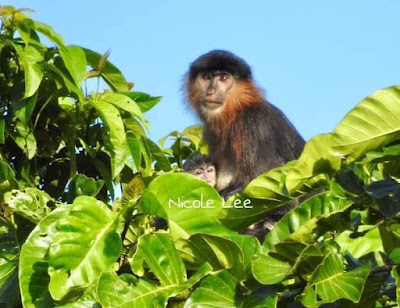 |
| “mystery monkey” evidence for a possible hybridization event between Nasalis larvatus and Trachypithecus cristatus in Lhota, Yap, Benedict, ... et Ruppert, 2022. |
Abstract
Interspecific hybridization in primates is common but hybridization between distantly related sympatric primate species is rarely observed in the wild. We present evidence for a possible hybridization event between Nasalis larvatus and Trachypithecus cristatus in the Lower Kinabatangan Wildlife Sanctuary, Sabah, through assessment of photographs. We used a set of categorical characters and metric measurements to compare the putative hybrid with the likely parent species. Nonmetric comparison showed that this “mystery monkey” is intermediate in several characters. Measurements of limb proportions on photographs showed that the brachial, humerofemoral, and intermembral indexes are above 100 for N. larvatus and below 100 for T. cristatus on all photographs, whereas the crural index is higher than 100 in both species and the distributions of this index in the two species overlap. Brachial and intermembral indices of the putative hybrid were similar to those of N. larvatus. Crural and humerofemoral indices were closer to the values for T. cristatus than those of N. larvatus. Multiple observers confirmed the occurrence of mixed-species groups in the area, and interspecific mating has been photographed. The putative hybrid is now an adult female and was last photographed in September 2020 with an infant and swollen breast, suggesting lactation. We propose further noninvasive fecal sampling for genetic analyses to confirm the origins of this “mystery monkey.” This case of hybridization may be related to anthropogenic changes to the landscape, whereby expansion of oil palm plantations confines N. larvatus and T. obscurus to narrow riverine forest patches along the Kinabatangan. This observation therefore also may have conservation implications, indicating limited mate access and dispersal opportunities for these threatened primates.
Stanislav Lhota, Jo Leen Yap, Mark Louis Benedict, Ken Ching, Bob Shaw, Ben Duncan Angkee, Nicole Lee, Vendon Lee, Jean-Jay Mao and Nadine Ruppert. 2022. Is Malaysia’s “Mystery Monkey” A Hybrid between Nasalis larvatus and Trachypithecus cristatus? An Assessment of Photographs. International Journal of Primatology. DOI: 10.1007/s10764-022-00293-z


